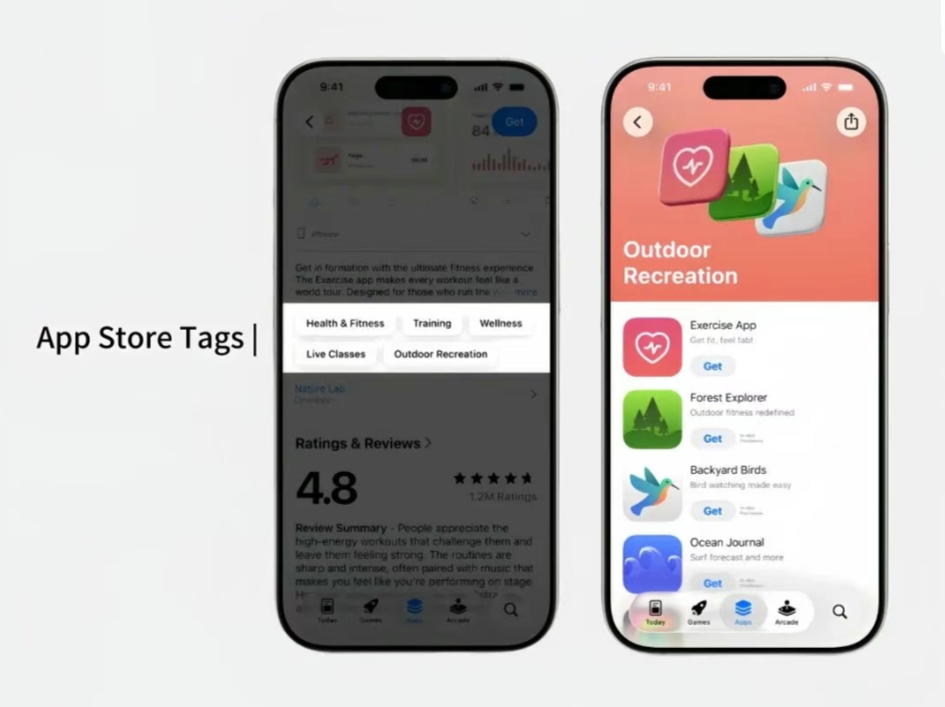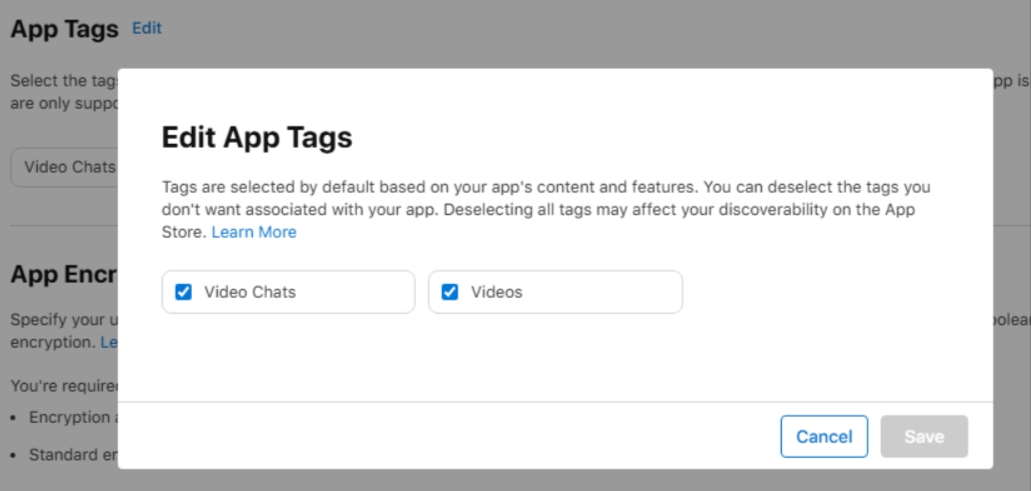
Loading...
Free consultation with ASO specialists
Doing ASO for the first time or have no idea how to carry out targeted optimization of your app?
We offer one-on-one customized services provided by app marketing specialists
App Store Tag Optimization Guide: Seize the Bonus of Contextualized Traffic
2025-07-21
What is App Tags?
App Tags It is a new feature launched by Apple's App Store, which automatically generates some short tags for each application and displays them on the search results and application details page to help users quickly understand the core features of the application. These tags are generated by Apple's system based on application metadata, AI analysis and manual review. Developers can view and manage these tags in App Store Connect, such as removing irrelevant tags. The emergence of App Tags has changed the distribution logic of the app store from traditional keyword search to more intelligent intent matching and structured recommendation.
The source and generation method of the tag: Apple uses large language models (LLM) to analyze the metadata submitted by apps in App Store Connect (including titles, subtitles, descriptions, keyword fields, etc.) and combines manual review to generate App Tags. This means that the tags reflect the core functions and uses of the app. Developers cannot add any tags on their own, but they can guide the system to generate expected tags by optimizing metadata.

App Tag Display Position:
-
Search results page: When users search, 1-2 tags may be displayed below the matched app results to let users "see at a glance" the characteristics of the app.
-
Application product page: In the middle of the application details page, all tags of the application are listed to help users further understand the functional classification of the application.
-
Tag aggregation page: When users click on any tag, they will be redirected to the aggregation page of that tag to view all applications with that tag. This actually creates a new traffic entry for developers.
Core objectives: App Tags aims to improve the discovery rate and matching accuracy of applications. Through tags, users can discover applications by theme or intent, not just relying on keyword searches. For developers, this means that the exposure of applications no longer completely depends on keyword stuffing or advertising budgets, but focuses more on the functional value of the application itself, metadata expression and user experience. This provides new opportunities for small and medium-sized developers to compete with large factory applications.
Why launch App Tags? (What it means for developers)
Apple launched App Tags, which has multiple considerations. It also brings new opportunities and challenges for developers:
-
Solving the App Discovery Challenge
The App Store has a huge number of applications, and users often have difficulty finding the applications they need. A large number of high-quality applications may be drowned out. App Tags helps users find applications that meet their needs more efficiently through a structured tag system, while also making it easier for developers' applications to be discovered by target users.
-
Create high-value traffic entry
The appearance of the tag aggregation page provides developers with a new traffic channel. When users click on a certain tag, their intentions are highly clear (for example, looking for applications such as "meditation" or "offline mode"), so users entering from the tag aggregation page often have greater conversion potential. If developers can occupy a favorable position in relevant tags, they will get a steady stream of accurate traffic.
-
Empowering small and medium-sized developers
In the past, the ranking of applications in the App Store largely depended on the number of downloads and advertising investment, making it difficult for small and medium-sized developers to compete with large factories. The introduction of App Tags makes application distribution pay more attention to the matching degree of functions and user intentions. As long as the application functions meet the needs of users and the metadata is optimized properly, even if the number of downloads is not dominant, there is a chance to be recommended to target users. This provides a fairer competitive environment for small teams and independent developers.
-
Drive precise matching and retention
App Tags encourage developers to define their app's core features and problems more clearly. When an app is tagged accurately, the users it attracts are often the target audience, thus improving download conversion rates and user retention rates. On the contrary, if the tags are inaccurate and attract irrelevant users, it may lead to high churn and poor ratings and reviews. Therefore, the tagging mechanism helps improve overall user experience and app quality.
-
Distribution Logic Change
The launch of App Tags marks the evolution of the distribution logic of the App Store. In the past, users mainly found applications through keyword searches, but in the future, the App Store will make more recommendations based on user intent, similar to the content distribution mechanism of TikTok. This change requires developers to adjust their strategies, shifting from optimizing keywords to optimizing the "semantic tags" and functional expressions of applications to adapt to the new discovery ecosystem.
How do App Tags work? (What do developers need to do?)
The generation and management process of App Store tags (App Tags) is highly automated and rigorous, with the core being the perfect combination of AI content understanding and manual review:
-
AI-generated suggested tags: The Apple system will deeply analyze the app metadata you submit in App Store Connect (such as name, description, keywords, etc.) and automatically generate a set of preliminary tag suggestions based on this.
-
Developer Review and Curation: These suggested tags will be clearly displayed in your App Store Connect dashboard. As a developer, you can review these tags and remove any that you feel are irrelevant or inappropriate. However, please note that you cannot add new tags yourself.
-
Submit and Manual Review: The tags you confirm to keep will be officially submitted to Apple. Then, the Apple team will conduct a strict manual review to ensure the quality, relevance, and compliance of the tags.
-
Final Display: Only App Tags that pass manual review will be displayed on the App Store for users to search and discover your app.
Action required by developers:
-
View and manage existing tags
-
Log in to App Store Connect and go to the "App Information" page of the target app.
-
Find the "App Store Tags" section and click "Edit".
-
Review system AI-generated suggested tags: Keep the tags that accurately reflect the core features or characteristics of your app. Remove irrelevant, inaccurate, or inappropriate tags. Developers cannot add new tags themselves; they can only select from the system suggestions.
-
Click "Save" to confirm the changes.

Note: If you remove all tags, it may affect the discoverability of your app, so keep at least some relevant tags.
-
Optimize metadata to guide tag generation
Since developers cannot directly add custom tags, optimizing metadata becomes a key means of guiding the system to generate expected tags. Specifically, you can start from the following aspects:
-
Title and subtitle: Incorporate keywords that reflect the core functionality or use case in the app name and subtitle. For example, if you want to be tagged for "offline mode," mention "offline use" in the title or subtitle.
-
Keyword field: Take full advantage of the App Store's keyword field (up to 100 characters) by filling it with terms that are closely related to your app's features. These words will be read by Apple's algorithm and affect the tags generated.
-
Application description: At the beginning of the app description, use concise language to highlight the main functions and features of the app. Make sure that the description includes the core concept words you want the system to recognize.
-
User Ratings and Reviews: Encourage users to use specific feature keywords in their reviews (such as "AR support" and "suitable for family use"). Although user reviews are not the direct basis for tag generation, Apple's algorithm will also consider the features mentioned by a large number of users.
👉The accuracy of metadata optimization directly determines the quality of tags, but manual layout of keywords and balancing character limits often take time and are difficult to achieve ideal results. If you need professional support in title optimization and keyword screening, please contact AppFast Customer Service Our ASO team can provide free keyword precise layout and metadata deep optimization services to help you efficiently bury tag clues and make it easier for Apple's algorithm to identify core functions.
-
Follow Apple's official guidance
Apple may provide guidance on tags in App Store Connect, such as what types of tags might be rejected. Developers should ensure they follow these rules and not attempt to manipulate tags through improper means.
Through the above steps, developers can influence the generation of App Tags to some extent, so that applications can obtain more appropriate tags, thereby improving exposure in search and aggregation pages.
How to optimize App Tags?
To make the most of the opportunities brought by App Tags, developers need to develop a systematic optimization strategy. The following four-step optimization method will help you effectively optimize App Tags:
-
View your own tag assignments
-
Log in to App Store Connect and check which tags Apple has automatically assigned to your app.
-
List these tags and compare them one by one with the core functions of the application and the needs of target users, and make a "tag-function-user" matching analysis table. For example, does the tag "meditation" correspond to your application's meditation function, and is it a point of concern for target users?
-
For tags with high matching degree, keep them; for irrelevant or easily misunderstood tags, uncheck them in the backend decisively. This step ensures that the tags displayed by your app are accurate and will not mislead users.

-
Reverse Engineering & Optimizing Metadata
Next, optimize your app's metadata in reverse for the target tags you want your app to get. That is, first clarify which tags you want the system to give your app (these tags should be directly related to the value provided by the app), and then bury the corresponding "clues" in the metadata to guide Apple's algorithm to generate these tags. Specific optimization points include:
-
Title and subtitle
The title is one of the most important metadata fields and should include the most core keywords as much as possible. The subtitle follows, and should also include key functional description words. Use concise and powerful words.
-
Keyword field
Apple allows up to 100 characters in the keyword field. Fill in the keywords you want to highlight, such as feature words and scenario words. Avoid piling up irrelevant words.
-
Application Description
Although the App Store search algorithm does not directly index long descriptions, Apple's tag generation model reads the description content. Therefore, in the opening paragraph of the description, use clear language to describe the main functions and features of the application, ensuring that it includes keywords corresponding to target tags.
-
User Reviews and Ratings
You can prompt satisfied users to mention key benefits of your app in their ratings and reviews via in-app prompts or social media. Make sure the prompting is natural and non-intrusive, and complies with Apple's ratings and reviews policy.
By optimizing the metadata above, you are actually "explaining" to Apple's AI what your app is and what it can do. When the metadata is highly relevant to the tags you expect, the system is more likely to assign these tags to your app.
-
Research Competitor Tags
"Know yourself and know your enemy, and you can fight a hundred battles without danger." While optimizing your own App Tags, you should also pay attention to the tags of your competitors. The methods for analyzing competitive products include:
-
View Competitor Tag List
Open the App Store, search for competing apps, go to their product pages and record all the tags they have. Compare these tags with the features of the competitors and evaluate their match. If the competitor has some tags that you don't have but are related to your app, it may mean that you have missed some keyword signals and need to strengthen them in the metadata.
-
Analyze Competitor Metadata
Check the titles, subtitles, keyword fields and descriptions of your competitors to see how they are laying out their keywords. Are there any words that appear repeatedly, corresponding to their tags? This can provide a reference for your metadata optimization.
-
Monitor competitors' Custom Product Pages (CPP)
If your competitors use custom product pages, you can see what exclusive pages they have designed for different search terms or tags. This may imply that they are focusing on operating some segmented traffic. You can learn from their strategies and develop a corresponding CPP plan for your core tags.
-
Mining User Reviews Keywords
Read the user reviews of competitors, and find out the keywords of functions or experiences that appear frequently. These words often reflect the points that users care most about, and are also the directions that Apple labels may cover.
Through competitive analysis, you can find the shortcomings and opportunities of your own optimization, and adjust strategies in time.
-
Linking traffic
The last step is to combine the optimization of App Tags with other promotion methods to form a linkage effect and maximize the traffic value brought by tags. Specifically, you can start from the following aspects:
-
Create a Custom Product Page (CPP)
Apple's custom product page feature allows developers to show different app description pages for specific search terms or scenarios. Create a dedicated custom product page for each core tag of the app (such as "meditation"), and display targeted feature highlights and scenario Ratings and Reviews. When users enter through the "meditation" tag page, the conversion rate will be greatly improved.
-
Place Search Ads for precise traffic
Use Apple Search Ads to target keywords related to tags and link ads to corresponding custom product pages. The ad traffic and organic tag traffic are unified on the landing page, improving conversion results. At the same time, downloads and interactions brought by ads will also increase the weight of your application under relevant tags, forming a positive cycle.
-
Strengthen metadata consistency
Ensure that the messages conveyed in tags, CPP and ads are consistent. For example, if you use the "family sharing" tag, then the highlights of family sharing should also be highlighted in the copywriting and screenshots of CPP, and the advertising materials should also focus on this point. This consistency helps users to build trust and makes Apple's algorithm more clear about the positioning of your application.
-
Monitor data and continuously optimize
After the traffic linkage is established, closely monitor various data indicators such as downloads from the tag aggregation page, conversion rates of ads, and CPP browsing download ratios. Based on data feedback, continuously optimize tag strategies and supporting content.
Through the above linkage strategy, you can effectively take over and convert the new traffic brought by App Tags, forming a virtuous circle of "tag exposure → CPP takeover → advertising conversion → weight increase → continuous distribution", so as to amplify the effect of App Tags optimization.
Advice for developers
The App Tags feature is gradually being rolled out worldwide, but as of mid-2025, it is primarily available in the US App Store and only for English apps and games. With the release of WWDC 2025, Apple has stated that it will expand to more countries and languages in the future. Therefore, for developers who publish globally, the full rollout of this feature is just a matter of time.
Advice for developers:
-
Review metadata immediately
Whether or not your app is currently covered by the tag, you should now start optimizing metadata. Clearly define the core features and user value of your app, select 3-5 of the most important tag directions, and embed relevant clues in the title, subtitle, keywords, etc. Early layout will allow you to take the lead when the tag function covers your market.
-
Prepare Custom Product Page
If you haven’t used custom product pages yet, we recommend getting familiar with them and creating a few versions. Design dedicated screenshots, copy, and preview videos for the core tags you expect to be assigned, highlighting the relevant features. Once Apple opens up tag clicks, you can immediately put these CPPs to use and boost your conversion.
-
Create a search ad campaign
Consider launching a search ad test for keywords related to target tags in the main market. The ads can be used to verify in advance which tag words can bring high-quality users and accumulate weight for natural rankings. When the tag aggregation page goes live, the combination of ads and natural traffic will be even more powerful.
-
Follow the US area dynamics
Since the US region is the first to launch App Tags, you can consider it as a test field. Keep a close eye on the performance of tags, user feedback, and any update announcements from Apple in the US region. This information will help you adjust your strategy and prepare for global promotion.
-
Keep patience and continuous optimization
The impact of App Tags is long-term and will not be immediate. The algorithm needs time to crawl and update tags, and users also need time to get used to discovering apps through tags. Therefore, be patient, continuously monitor data, and constantly optimize your tags and metadata based on feedback. Over time, you will see the performance of your app in search and recommendations gradually improve.
Overall, App Tags bring new variables and opportunities to app distribution. Developers should embrace this change and start optimizing their app store profiles now. The App Store is becoming smarter, and the era of distribution centered on user intent has arrived Developers who have optimized their App Tags in advance will be in a favorable position in the future application ecosystem. Act now and let your app stand out in the era of intelligent distribution!
Act now and get ahead of the game!
If you are struggling with how to make App Tags accurately match the core value of the application, and want to take the lead in the intelligent distribution wave of Apple's ecosystem, you may as well let professional ASO services speed up for you - visit AppFast immediately. We focus on the full-chain optimization of the App Store, from precise metadata layout to ratings and reviews management, helping you efficiently guide target tags and improve conversion results.
🚀 Get free App diagnosis plan:
✅ Deeply scan the coverage of related words in tags of title/subtitle/keywords, and find out metadata vulnerabilities
✅ Generate a comparison report of competitor tag strategies to clearly understand the gaps and opportunities
✅ Customized 3-step tag guidance plan to let Apple algorithm quickly identify your core features
Don't miss the golden period of App Tags layout, take action immediately, and let your application be more easily discovered by target users in search results and tag aggregation pages!
Related recommendations

